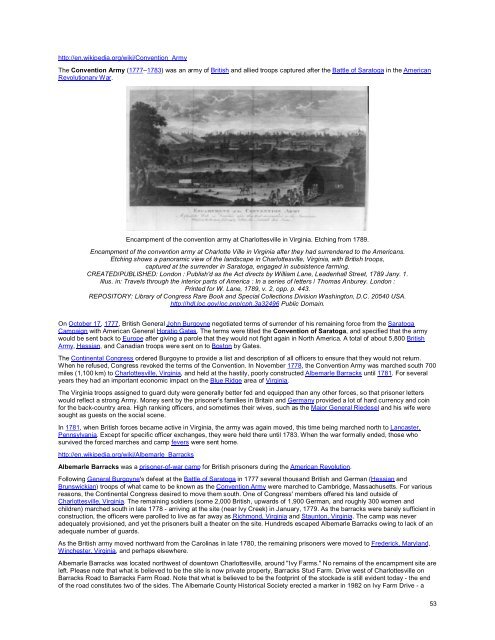Grand Masters of Scotland - Onondaga and Oswego Masonic ...
Grand Masters of Scotland - Onondaga and Oswego Masonic ...
Grand Masters of Scotland - Onondaga and Oswego Masonic ...
You also want an ePaper? Increase the reach of your titles
YUMPU automatically turns print PDFs into web optimized ePapers that Google loves.
http://en.wikipedia.org/wiki/Convention_Army<br />
The Convention Army (1777–1783) was an army <strong>of</strong> British <strong>and</strong> allied troops captured after the Battle <strong>of</strong> Saratoga in the American<br />
Revolutionary War.<br />
Encampment <strong>of</strong> the convention army at Charlottesville in Virginia. Etching from 1789.<br />
Encampment <strong>of</strong> the convention army at Charlotte Ville in Virginia after they had surrendered to the Americans.<br />
Etching shows a panoramic view <strong>of</strong> the l<strong>and</strong>scape in Charlottesville, Virginia, with British troops,<br />
captured at the surrender in Saratoga, engaged in subsistence farming.<br />
CREATED/PUBLISHED: London : Publish'd as the Act directs by William Lane, Leadenhall Street, 1789 Jany. 1.<br />
Illus. in: Travels through the interior parts <strong>of</strong> America : In a series <strong>of</strong> letters / Thomas Anburey. London :<br />
Printed for W. Lane, 1789, v. 2, opp. p. 443.<br />
REPOSITORY: Library <strong>of</strong> Congress Rare Book <strong>and</strong> Special Collections Division Washington, D.C. 20540 USA.<br />
http://hdl.loc.gov/loc.pnp/cph.3a32496 Public Domain.<br />
On October 17, 1777, British General John Burgoyne negotiated terms <strong>of</strong> surrender <strong>of</strong> his remaining force from the Saratoga<br />
Campaign with American General Horatio Gates. The terms were titled the Convention <strong>of</strong> Saratoga, <strong>and</strong> specified that the army<br />
would be sent back to Europe after giving a parole that they would not fight again in North America. A total <strong>of</strong> about 5,800 British<br />
Army, Hessian, <strong>and</strong> Canadian troops were sent on to Boston by Gates.<br />
The Continental Congress ordered Burgoyne to provide a list <strong>and</strong> description <strong>of</strong> all <strong>of</strong>ficers to ensure that they would not return.<br />
When he refused, Congress revoked the terms <strong>of</strong> the Convention. In November 1778, the Convention Army was marched south 700<br />
miles (1,100 km) to Charlottesville, Virginia, <strong>and</strong> held at the hastily, poorly constructed Albemarle Barracks until 1781. For several<br />
years they had an important economic impact on the Blue Ridge area <strong>of</strong> Virginia.<br />
The Virginia troops assigned to guard duty were generally better fed <strong>and</strong> equipped than any other forces, so that prisoner letters<br />
would reflect a strong Army. Money sent by the prisoner's families in Britain <strong>and</strong> Germany provided a lot <strong>of</strong> hard currency <strong>and</strong> coin<br />
for the back-country area. High ranking <strong>of</strong>ficers, <strong>and</strong> sometimes their wives, such as the Major General Riedesel <strong>and</strong> his wife were<br />
sought as guests on the social scene.<br />
In 1781, when British forces became active in Virginia, the army was again moved, this time being marched north to Lancaster,<br />
Pennsylvania. Except for specific <strong>of</strong>ficer exchanges, they were held there until 1783. When the war formally ended, those who<br />
survived the forced marches <strong>and</strong> camp fevers were sent home.<br />
http://en.wikipedia.org/wiki/Albemarle_Barracks<br />
Albemarle Barracks was a prisoner-<strong>of</strong>-war camp for British prisoners during the American Revolution.<br />
Following General Burgoyne's defeat at the Battle <strong>of</strong> Saratoga in 1777 several thous<strong>and</strong> British <strong>and</strong> German (Hessian <strong>and</strong><br />
Brunswickian) troops <strong>of</strong> what came to be known as the Convention Army were marched to Cambridge, Massachusetts. For various<br />
reasons, the Continental Congress desired to move them south. One <strong>of</strong> Congress' members <strong>of</strong>fered his l<strong>and</strong> outside <strong>of</strong><br />
Charlottesville, Virginia. The remaining soldiers (some 2,000 British, upwards <strong>of</strong> 1,900 German, <strong>and</strong> roughly 300 women <strong>and</strong><br />
children) marched south in late 1778 - arriving at the site (near Ivy Creek) in January, 1779. As the barracks were barely sufficient in<br />
construction, the <strong>of</strong>ficers were parolled to live as far away as Richmond, Virginia <strong>and</strong> Staunton, Virginia. The camp was never<br />
adequately provisioned, <strong>and</strong> yet the prisoners built a theater on the site. Hundreds escaped Albemarle Barracks owing to lack <strong>of</strong> an<br />
adequate number <strong>of</strong> guards.<br />
As the British army moved northward from the Carolinas in late 1780, the remaining prisoners were moved to Frederick, Maryl<strong>and</strong>,<br />
Winchester, Virginia, <strong>and</strong> perhaps elsewhere.<br />
Albemarle Barracks was located northwest <strong>of</strong> downtown Charlottesville, around "Ivy Farms." No remains <strong>of</strong> the encampment site are<br />
left. Please note that what is believed to be the site is now private property, Barracks Stud Farm. Drive west <strong>of</strong> Charlottesville on<br />
Barracks Road to Barracks Farm Road. Note that what is believed to be the footprint <strong>of</strong> the stockade is still evident today - the end<br />
<strong>of</strong> the road constitutes two <strong>of</strong> the sides. The Albemarle County Historical Society erected a marker in 1982 on Ivy Farm Drive - a<br />
53







![Richard [Nicholls] Harison / Harrison - Onondaga and Oswego ...](https://img.yumpu.com/24950065/1/190x245/richard-nicholls-harison-harrison-onondaga-and-oswego-.jpg?quality=85)

![Richard [Nicholls] Harison / Harrison - Onondaga and Oswego ...](https://img.yumpu.com/24950063/1/190x245/richard-nicholls-harison-harrison-onondaga-and-oswego-.jpg?quality=85)







